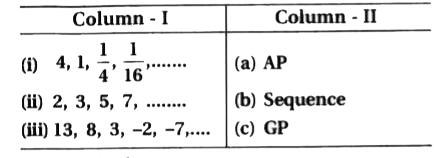Two sequences cannot be in both AP and GP together.Solution in Gujrati
The correct Answer is:1
Step by step video, text & image solution for Two sequences cannot be in both AP and GP together. by Maths experts to help you in doubts & scoring excellent marks in Class 11 exams.
Updated on:21/07/2023Topper's Solved these Questions
- SEQUENCE AND SERIESBook:KUMAR PRAKASHANChapter:SEQUENCE AND SERIESExercise:Solutions of NCERT Exemplar Problems -Matching The Columns
Explore 2 Videos
- SEQUENCE AND SERIESBook:KUMAR PRAKASHANChapter:SEQUENCE AND SERIESExercise:Solutions of NCERT Exemplar Problems -Question of Module
Explore 19 Videos
- SEQUENCE AND SERIESBook:KUMAR PRAKASHANChapter:SEQUENCE AND SERIESExercise:Solutions of NCERT Exemplar Problems -Fillers
Explore 3 Videos
- RELATIONS AND FUNCTIONSBook:KUMAR PRAKASHANChapter:RELATIONS AND FUNCTIONSExercise:Solutions of NCERT Exemplar Problems (Question of Module)
Explore 16 Videos
- SETSBook:KUMAR PRAKASHANChapter:SETSExercise:QUESTION OF MODULE
Explore 28 Videos
Similar Questions
Match the following

View SolutionThe terms 1,1,2,3,5,8,13,……respresents which sequence?
View SolutionIf a, b and c are in GP, then the value of a−bb−c is equal to……..
View SolutionA={−1,0},B={−1,0,1}, then find A×BandB×A
View SolutionA{x∈R∣x2+3=0} is a set of………type.
View SolutionLet the positive numbers a,b,c,d be in AP. Then abc,abd,acd,bcd are (2001, 1M) not in AP/GP/HP (b) in AP in GP (d) in HP
View SolutionIf the pth,qth & rth terms of an AP are in GP. Find the common ratio of the GP.
View SolutionTwo sequences cannot be in both AP and GP together .
View SolutionThree positive numbers form an increasing GP. If the middle term in this GP is doubled, then new numbers are in AP. Then, the common ratio of the GP is
View SolutionThree positive numbers form an increasing GP. If the middle terms in this GP is doubled, the new numbers are in AP. Then, the common ratio of the GP is
View SolutionTwo sequences cannot be in both AP and GP together .
View SolutionIn a sequence of (4n + 1) terms the first (2n + 1) terms are in AP whose common difference is 2, and the last (2n + 1) terms are in GP whose common ratio is 0.5. If the middle terms of the AP and GP are equal, then the middle term of the sequence is
View SolutionProve that three unequal numbers cannot be in GP when each number increased (or decreased) by the same quantity are in AP.
View SolutionAP ||GP
View SolutionThree positive numbers form an increasing GP. If the middle terms in this GP is doubled, the new numbers are in AP. Then, the common ratio of the GP is
View Solution